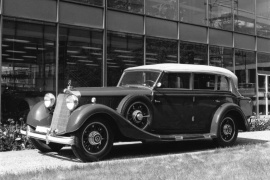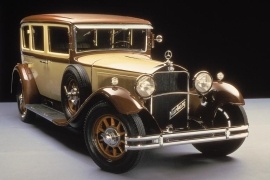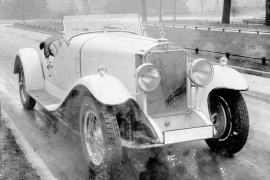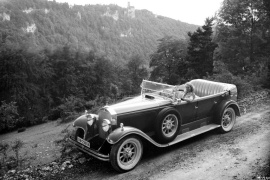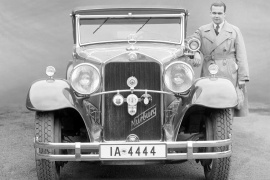MERCEDES BENZ Typ Nurburg Models/Series Timeline, Specifications & Photos
First production year: 1928
Engines: Gasoline
Even though this car is part of the Nurburg lineup, it didn't carry over the name in the automaker's official listings, but it was commonly used due to naming confusion.
Mercedes-Benz prepared an update for the longest-produced vehicle in its lineup, the W08, a car that had to stay on the assembly lines due to the 1930s Great Depression. The automaker knew that creating an entirely new vehicle for that segment would increase production costs. So, it just did some tweaks here and there to make the W08 more attractive, but without high costs.
The automaker ended the production of the Nurburg 460 in December 1933 and, in February 1934, started the production of the 500. In March, the German carmaker added the 500 version with a supercharger, and customers were confused. Mercedes-Benz noticed that and added the K letter for the supercharged version and N for the naturally aspirated model. But that added even more confusion between the "Nurburg" and "Normal."
That confusion remained, and sometimes 500N were named as Nurburg, mainly because it used the technical underpinnings carried over from the W08, like the Cabriolet F. This model was the last to use the same chassis and solid rear axle developed in the '20s. Moreover, it was fitted with wooden wheels. On the other hand, the bodywork sported a new design with a tilted, rounded radiator instead of the straight-up, wedged-shaped one from the W08 I. Its slightly tilted windshield and bodywork were similar to those found on the 500 model. Moreover, its four doors were hinged to the B-pillars so the front occupants could exit faster and open the rear doors for the most important passengers.
Under the hood, the car sported a five-liter engine that provided 100 ponies in the W08 II version, which were increased to 110 PS for the W08 III.
During his work for Mercedes-Benz, Ferdinand Porsche developed the Nurburg lineup, also known as the W08, which was available in a few body shapes but, most importantly, as a sedan.
The Nurburg lineup replaced the former W03, 04, and 05 models, and the car's name came from the grueling testing program created by the German automaker. That test was performed for 13 days on the Nurburgring racetrack and the vehicle covered 20,000 km (12,427 miles). As expected, the sedan version was the most sought-after version, and it was also the most luxurious one.
Since the Nurburg Sedan was powered by an inline-eight, it forced the automaker to create a longer engine compartment. But that didn't spoil the car's look, on au contrary. At the front, Mercedes-Benz installed a curved chromed bar between the thin fenders, where it mounted the headlights. That design solution became a signature for the three-pointed-star brand from Stuttgart. From its profile, the high-chassis system and the four-door bodywork offered a luxurious image for customers. Still, in those times, automakers didn't install a specific luggage compartment, so after the cabin, the vehicle ended abruptly. Yet, a rack was added behind for suitcases or chests.
Featuring the longest wheelbase in its family, the Sedan provided enough room for up to five occupants. Depending on the version, the rear seats could've been completely separated by the driver and the side occupant, which was most of the time a guard. Mercedes-Benz installed a four-spoke steering wheel, which also sported the controls for ignition timing and air/fuel ratio.
Mercedes-Benz installed the same engine with different power outputs for the entire Nurburg range. The 4.6-liter supercharged version provided 80 hp, while the full-option model featured a 5.0-liter 100 hp unit.
Mercedes-Benz introduced the W08 lineup in 1928, and it was the first car offered by the German carmaker with an inline-eight powerplant, and the Sport Roadster was a one-of-a-kind example.
While it is not precisely how such versions of the W08 were produced, there are few things clearly known: it was designed by no other than Ferdinand Porsche, and two vehicles appeared in 1929 on the Alpine Rally and on the 8-hour ADAC (the German Automobile Club) race. These were driven by the famous Rudolf Caracciola and Otto Merz. These cars were not shown in the carmaker's brochure nor offered for sale.
Designed on a shortened version of the W08's chassis, the Sport Roadster was a race car built with one purpose: to win races. Thus, the carmaker decided to make it around the engine compartment. At the front, it sported the big radiator protected by an additional mesh and placed the headlamps in a way that they didn't block the cooling area. Since it was not intended to be used on public roads with open traffic, it didn't feature a front or a rear bumper. Unlike the rest of the W08 range, the Sport Roadster featured wired wheels instead of wooden (artillery) ones.
The cockpit was tailored around the drivers, and they offered just two seats, so it could pass the mandatory race specs. Moreover, the seat was fixed on the floor. In front of the driver, a four-spoke steering wheel dominated the driver's side, while the dials were placed in the middle of the dashboard.
Under the hood, Mercedes-Benz installed a 4.6-liter inline-eight fed by carburetors, and it offered the same power as the rest of the W08 range: 80 PS (79 hp). Power was sent to the rear wheels via a four-speed manual transmission.
Ferdinand Porsche worked for Mercedes-Benz when he developed a few vehicles, such as the Nurburg lineup or W08, and the Cabriolet D was part of that range of vehicles.
Developed on a high chassis construction, the Nurburg replaced the six-cylinders vehicles from the W03/04/05 lineup. Its name came from the extensive endurance testing program imagined by the German carmaker when a car ran 20.000 km (12.427 miles) in 13 days on the Nurburgring racetrack. The main model was a sedan, but since the convertibles were also in high demand, the carmaker offered them in a few open-top versions as well, such as the Cabriolet D.
Due to the long, inline-eight engine, the car featured a long engine compartment. Just like its siblings, it featured a pair of headlights mounted on a curved chromed bar between the front fenders. From its sides, the curved front fenders were extended toward the back of the vehicle with a set of side steps. Its four-door configuration made it an easier car to live with, especially when the owners had to transport more than two passengers.
Even though it sported a shorter wheelbase than the Cabriolet C, the D-version still provided enough room for five adult passengers inside. The cabin featured a dash panel covered with wood, while the instrument panel took center stage. Its four-spoke steering wheel featured the commands for ignition timing and fuel mixture.
Mercedes-Benz installed the same engine with different power outputs for the entire Nurburg range. The 4.6-liter supercharged version provided 80 hp, while the full-option model featured a 5.0-liter 100 hp unit.
The Nurburg was the last vehicle developed by Ferdinand Porsche while he worked for Mercedes-Benz, a range of cars that included the rare Cabriolet C version.
Developed on a high chassis construction, the Nurburg replaced the six-cylinders vehicles from the W03/04/05 lineup. Its name came from the extensive endurance testing program imagined by the German carmaker when a car ran 20.000 km (12.427 miles) in 13 days on the Nurburgring racetrack. The main model was a sedan, but since customers asked for a personal luxury convertible, that was the C-version.
Since Ferdinand Porsche built the Nurburg on a high-chassis system, the convertible version adopted the same platform. That led to high ground clearance. The car featured a long engine compartment to accommodate the inline-eight engine. Like most of the premium carmakers from that era, a curved chromed bar between the front fenders supported the headlights. Worth mentioning that the Nurburg and the Cabriolet C, respectively, were the last Mercedes-Benz that sported wooden spoke wheels.
Its cabin provided room for five, with two individual seats at the front and a bench in the rear. The carmaker covered the dash panel with wood, and the instrument panel took center stage. Its four-spoke steering wheel featured the commands for ignition timing and fuel mixture.
Mercedes-Benz installed the same engine with different power outputs for the entire Nurburg range. The 4.6-liter supercharged version provided 80 hp, while the full-option model featured a 5.0-liter 100 hp unit.
